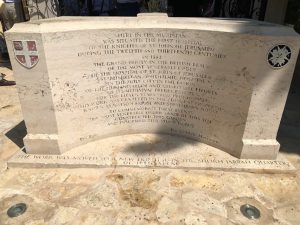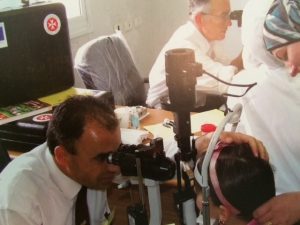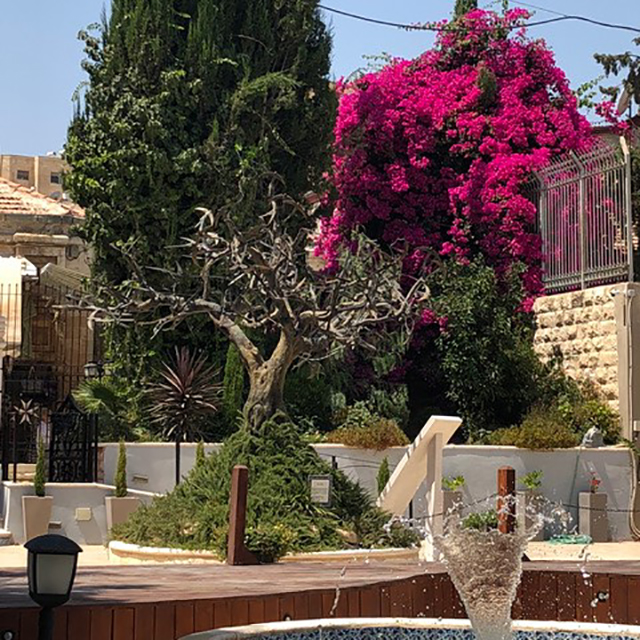Pro Fide, pro Utilitate Hominum
(For the Faith and for the Benefit of Mankind)
Situated on a gentle hillock in Jerusalem is the iconic St John Eye Hospital. The institution is an international ophthalmic landmark. It is the oldest and only charitable provider of eye care in the region. The hospital provides eye care to Palestinians in East Jerusalem, the West Bank, and Gaza in addition to anyone and everyone who seeks help. The hospital also serves as a base that provides services and supports rural eye clinics throughout Palestine and Gaza through regular mobile outreach. Patients who need surgery are referred to one of the St John satellite hospitals in the West Bank and Gaza, or to the St John Eye Hospital in Jerusalem.
The origin of the St John Eye Hospital (SJEH) dates to the year 1070 when it was founded as a hospice, and it has operated more or less continuously ever since. It is the oldest ophthalmic hospital in the world. The St John Eye Hospital served the European Christian crusaders who traveled to Jerusalem in the Middle Ages and pilgrims making the long journey from around the world to the Holy Land.

Today, SJEH boasts a full complement of fellowship-trained ophthalmic sub-specialists, a day case surgical suite, a refractive surgery suite, and a research lab. There are brand new satellite St John Eye Hospitals in Hebron and in Gaza with surgical services and surgical capacity is being developed at the St John Eye Clinic in Anabta in the north of Palestine. SJEH has an ophthalmology residency training program, runs the only ophthalmic nurse training program in the region at the Sir Stephen Miller School of Nursing which is affiliated with the University of West London in the UK and has been involved in the Rapid Assessment of Avoidable Blindness (RAAB) studies in Palestine. Dr. David Verity at the famed Moorfields Eye Hospital in London who serves as the Order of St John of Jerusalem’s global Hospitaller has founded the St John Ophthalmic Association which focuses on training and research.
Most exciting is the new eye clinic and lovely rest area with fountains situated on the site of the original St John Hospice in the Muristan section of the bustling old city of Jerusalem inside the walls and around the corner from the Church of the Holy Sepulchre. People in the old city can access basic eye care and go to the main hospital in East Jerusalem for more sophisticated care if needed. The opportunity to visit the St John Eye Clinic in the Muristan is a great reason to revisit Jerusalem.
SJEH, its satellite hospitals, and its outreach services are funded by the St John of Jerusalem societies across the globe, governments including USAID, private donors, and private foundations. The SJEH hospitals welcome all patients regardless of religion, ethnicity, or ability to pay for services.

Whilst SJEH is a tertiary eye hospital of great repute, it serves patients who come from a very poor developing country environment which is Palestine and Gaza. In 1882 when England’s Queen Victoria supported the building a new hospital outside the walls of the old city, trachoma was the main issue causing blindness in the people of the Holy Land. The ancient Bedouin people live in settlements now and often do not know where eye care services are or do not have the resources to access them. Many of the challenges faced by people in developing countries are faced by the rural people of Palestine. SJEH’s mobile eye units are critical to reducing blindness and regularly visit health care delivery points in the Palestinian territory and Gaza providing eye examinations and referrals to ophthalmic surgical facilities.
The St John of Jerusalem Eye Hospital Group is a charitable foundation that operates the hospital in Jerusalem and its satellite. It is administered by a Board of Trustees which reports to The Most Venerable Order of Hospital of St John of Jerusalem which is a chivalric order headed by Her Majesty Queen Elizabeth II and whose patron is Prince Richard, Duke of Gloucester, who is very active in the Order.
This is quoted from the organization’s website – www.stjohneyehospital.org:
“At this moment in our history of 125 years (2007), constrained by political circumstances, we serve the Palestinian people of East Jerusalem (approximately 250,000), the West Bank (approximately 2.5 million) and Gaza (approximately 1.5 million). This impoverished population, increased by about 1 million people in the last six years, and in whom their high prevalence of blindness emphasizes the need for our services and the continuing relevance to our mission.”
During the current global COVID-19 pandemic, services at the Jerusalem hospital and rural outreach have been reduced to approximately 40% of capacity except in Gaza. All necessary measures are implemented to protect staff and patients alike and services are picking up well.
As a member of the Order of St John of Jerusalem, I had the privilege of visiting the St John Eye Hospital a few years ago. I enjoyed the opportunity to work with the SJEH staff at the main hospital and with the mobile eye teams during a month-long volunteer visit. Traveling with the mobile eye team was an opportunity to observe life in another culture and to enjoy, within our unit, eye care as it is practiced in rural Palestine.
We were welcomed by a Palestinian guard when we arrived at our rural destination; a simple, attractive one-story building that served as our eye clinic. People were gathered outside awaiting the eye team. They would become our patients, many accompanied by relatives and family caretakers.
The mobile eye team quickly set up an efficient system to examine and treat patients who had assembled. The queue formed quietly and waited patiently to be examined. Two examination stations were created, and the ophthalmology nurse/medical assistant and I worked efficiently side by side at slit lamp stations (photograph). The clinical session ended when all patients had been examined and clinical dispositions determined. Back then, patients who had been identified as candidates for surgery, most of them for cataract surgery, were appointed to travel to Jerusalem to receive their surgical care at SJEH. With surgical capacity at Hebron and Gaza and under development at Anabta, patients no longer have to travel to Jerusalem. The team returned to Jerusalem together in the mobile van later in the afternoon via a severe rural landscape amidst scattered dwellings and olive groves.
The experience was yet another example of compassionate, quality eye care based on the principle that all people, regardless of political considerations, economic environment, ethnicity, or religion have the Right to Sight.
Larry Schwab, Morgantown, West Virginia
Victoria M. Sheffield, Alexandria, Virginia
February 6, 2021

